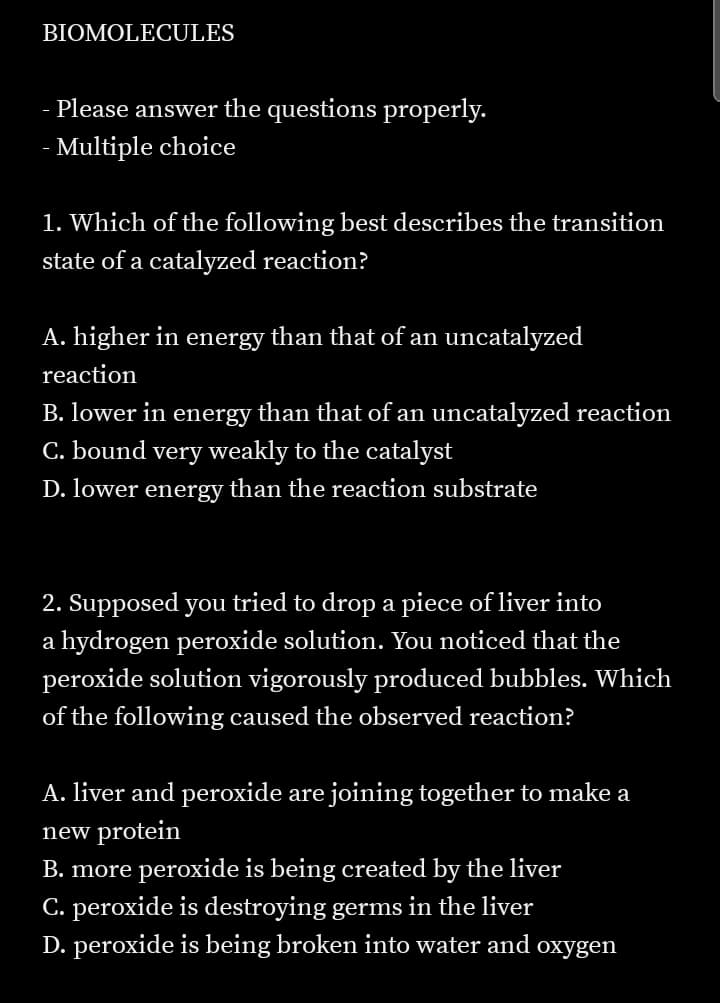BIOMOLECULES Please answer the questions properly. - Multiple choice 1. Which of the following best describes the transition state of a catalyzed reaction? A. higher in energy than that of an uncatalyzed reaction B. lower in energy than that of an uncatalyzed reaction C. bound very weakly to the catalyst D. lower energy than the reaction substrate 2. Supposed you tried to drop a piece of liver into a hydrogen peroxide solution. You noticed that the peroxide solution vigorously produced bubbles. Which of the following caused the observed reaction? A. liver and peroxide are joining together to make a new protein B. more peroxide is being created by the liver C. peroxide is destroying germs in the liver D. peroxide is being broken into water and oxygen
BIOMOLECULES Please answer the questions properly. - Multiple choice 1. Which of the following best describes the transition state of a catalyzed reaction? A. higher in energy than that of an uncatalyzed reaction B. lower in energy than that of an uncatalyzed reaction C. bound very weakly to the catalyst D. lower energy than the reaction substrate 2. Supposed you tried to drop a piece of liver into a hydrogen peroxide solution. You noticed that the peroxide solution vigorously produced bubbles. Which of the following caused the observed reaction? A. liver and peroxide are joining together to make a new protein B. more peroxide is being created by the liver C. peroxide is destroying germs in the liver D. peroxide is being broken into water and oxygen
Biochemistry
9th Edition
ISBN:9781319114671
Author:Lubert Stryer, Jeremy M. Berg, John L. Tymoczko, Gregory J. Gatto Jr.
Publisher:Lubert Stryer, Jeremy M. Berg, John L. Tymoczko, Gregory J. Gatto Jr.
Chapter1: Biochemistry: An Evolving Science
Section: Chapter Questions
Problem 1P
Related questions
Question

Transcribed Image Text:BIOMOLECULES
Please answer the questions properly.
- Multiple choice
1. Which of the following best describes the transition
state of a catalyzed reaction?
A. higher in energy than that of an uncatalyzed
reaction
B. lower in energy than that of an uncatalyzed reaction
C. bound very weakly to the catalyst
D. lower energy than the reaction substrate
2. Supposed you tried to drop a piece of liver into
a hydrogen peroxide solution. You noticed that the
peroxide solution vigorously produced bubbles. Which
of the following caused the observed reaction?
A. liver and peroxide are joining together to make a
new protein
B. more peroxide is being created by the liver
C. peroxide is destroying germs in the liver
D. peroxide is being broken into water and oxygen
Expert Solution
This question has been solved!
Explore an expertly crafted, step-by-step solution for a thorough understanding of key concepts.
Step by step
Solved in 4 steps

Recommended textbooks for you

Biochemistry
Biochemistry
ISBN:
9781319114671
Author:
Lubert Stryer, Jeremy M. Berg, John L. Tymoczko, Gregory J. Gatto Jr.
Publisher:
W. H. Freeman

Lehninger Principles of Biochemistry
Biochemistry
ISBN:
9781464126116
Author:
David L. Nelson, Michael M. Cox
Publisher:
W. H. Freeman

Fundamentals of Biochemistry: Life at the Molecul…
Biochemistry
ISBN:
9781118918401
Author:
Donald Voet, Judith G. Voet, Charlotte W. Pratt
Publisher:
WILEY

Biochemistry
Biochemistry
ISBN:
9781319114671
Author:
Lubert Stryer, Jeremy M. Berg, John L. Tymoczko, Gregory J. Gatto Jr.
Publisher:
W. H. Freeman

Lehninger Principles of Biochemistry
Biochemistry
ISBN:
9781464126116
Author:
David L. Nelson, Michael M. Cox
Publisher:
W. H. Freeman

Fundamentals of Biochemistry: Life at the Molecul…
Biochemistry
ISBN:
9781118918401
Author:
Donald Voet, Judith G. Voet, Charlotte W. Pratt
Publisher:
WILEY

Biochemistry
Biochemistry
ISBN:
9781305961135
Author:
Mary K. Campbell, Shawn O. Farrell, Owen M. McDougal
Publisher:
Cengage Learning

Biochemistry
Biochemistry
ISBN:
9781305577206
Author:
Reginald H. Garrett, Charles M. Grisham
Publisher:
Cengage Learning

Fundamentals of General, Organic, and Biological …
Biochemistry
ISBN:
9780134015187
Author:
John E. McMurry, David S. Ballantine, Carl A. Hoeger, Virginia E. Peterson
Publisher:
PEARSON